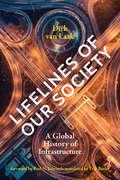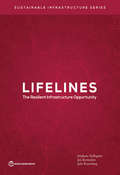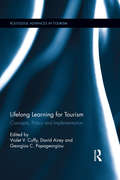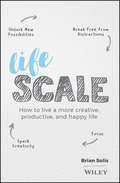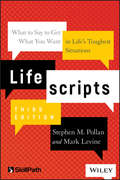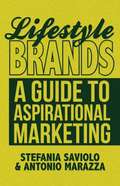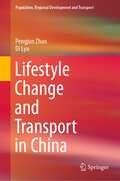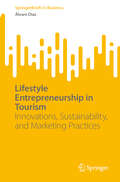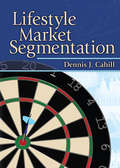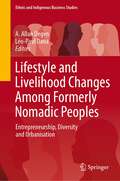- Table View
- List View
LifePass: A Groundbreaking Approach to Goal Setting
by Payal Kadakia'LifePass is a powerful guide for anyone who wants to take that first step towards achieving their goals.' - JAY SHETTYIntroducing The LifePass Method: A unique method of goal setting from the founder of ClassPass that will help you hone in on your feelings, screen out unnecessary distractions, and live a successful and fulfilling life based on your deepest desires. When Payal Kadakia let go of the pressure to achieve a traditional kind of success, she tuned in to her calling and built ClassPass into a multi-million pound company. In LifePass, she shares the unique how she changed her approach to not just business, but to her life. In LifePass, you will learn how to:- Focus on what's meaningful to you- Embrace all parts of your identity- Push past expectations to hear your own voice- Turn failure into learning opportunities- Make money work for you, instead of working for it- Manage your time guilt-free- Build a supportive tribe of people around you- Set actionable goals aligned to your dream'LifePass is a masterclass on how to live the life you've always wanted and thrive.' - ARIANNA HUFFINGTON
LifePass: Develop the Mindset, Techniques, and Goals to Optimize Your Life
by Payal KadakiaA signature goal-setting method to unlock the life you want, from the founder of ClassPass.Grant yourself permission to plan and prioritize your life in connection to your calling. When Payal Kadakia let go of the pressure to achieve a traditional kind of success, she tuned into her calling and built ClassPass into a billion-dollar business. In LifePass, she shares her signature goal-setting method that not only changed her approach to her career, but her entire life. You will learn to push through limits, fuel your life with purpose, and become an expert at achieving your goals—both professionally and personally. It's time to live by your own rules. LifePass shows you how.
LifeSpan Inc.: Abbott Northwestern Hospital
by Melvyn A.J. MenezesRaises the powerful issues of measuring marketing performance in a not-for-profit services setting. Also raises several interesting ethical issues. LifeSpan Inc., a Minneapolis based not-for-profit organization is the parent holding company of three hospitals and several health services corporations. Abbott Northwestern, LifeSpan's premier hospital, adopted a very market oriented approach to increase its share of a business that was both shrinking in size and becoming increasingly competitive. The company initiated a telemarketing advertising campaign which resulted in a flood of inquiries. The marketing group would like to nearly double the advertising budget; the board of directors would like some evidence that advertising, phone calls, inquiries, and other programs lead to filled beds and increased business.
LifeStyled: Your Guide to a More Organized & Intentional Life
by Shira GillTransform your entire life by cutting mental clutter, reducing overwhelm, and simplifying your daily routines with this inspiring and comprehensive guide from the bestselling author of Minimalista and Organized Living.As a professional home organizing expert with a diverse roster of clients ranging from students to CEOs, Shira Gill realized that almost everyone she worked with was overextended, overscheduled, and overwhelmed. So, using her signature blend of practical minimalism and organization, Shira designed a game-changing framework to streamline and simplify every part of your life, regardless of lifestyle or budget.LifeStyled is built around three key steps: adjusting volume, creating systems, and implementing habits. Applying these tools, you can transform your home, life, mindset, and schedule with accessible tips and quick wins—little things you can integrate or practice for quick, transformative results.Chapters cover health, home, relationships, career, finance, and personal development with actionable prompts to help you: Learn realistic strategies to optimize your sleep, nutrition, and overall wellness.Implement simple habits and routines to create and maintain a home that feels good.Cut the relationship clutter and invest in meaningful connections and community.Redefine success on your own terms and align your financial strategy with your values.Prioritize activities that help you feel energized, engaged, and fully alive.Disrupt unproductive thought patterns and create motivating new narratives.Shira has dedicated her career to helping people gain clarity and activate their best selves, even when they are short on time or capacity. In LifeStyled, she shows readers how to achieve more ease, alignment, and freedom, one tiny step at a time.
Lifeboat: Navigating Unexpected Career Change and Disruption
by Maggie CraddockToday&’s hardworking professionals are navigating sudden waves of financial stress, management shakeups, and downsizing. Using the experiences of Titanic survivors as a powerful metaphor, executive coach Maggie Craddock offers lessons for a transformative approach to our professional lives, one that recognizes that &“every man for himself&” doesn&’t work long-term. Lifeboat is organized as a series of key questions we all need to ask ourselves when facing unexpected career disruption or difficult changes at our existing jobs. These questions help readers clarify their authentic priorities, assess the group energy that guides a particular workplace, and identify the type of job that will help them reach their true potential.
Lifecycle Events and Their Consequences: Job Loss, Family Change, and Declines in Health
by Kenneth A. Couch, Mary C. Daly, and Julie M. ZissimopoulosIn Lifecycle Events and Their Consequences: Job Loss, Family Change, and Declines in Health, editors Kenneth A. Couch, Mary C. Daly, and Julie Zissimopoulos bring together leading scholars to study the impact of unexpected life course events on economic welfare. The contributions in this volume explore how job loss, the onset of health limitations, and changes in household structure can have a pronounced influence on individual and household well-being across the life course. Although these events are typically studied in isolation, they frequently co-occur or are otherwise interrelated. This book provides a systematic empirical overview of these sometimes uncertain events and their impact. By placing them in a unified analytical framework and approaching each of them from a similar perspective, Lifecycle Events and Their Consequences illustrates the importance of a coherent approach to thinking about the inter-relationships among these shifts. Finally, this volume aims to set the future research agenda in this important area.
Lifelines of Our Society: A Global History of Infrastructure (Infrastructures)
by Dirk van LaakA comprehensive history and examination of global infrastructures and the outsized role they play in our lives.Infrastructure is essential to defining how the public functions, yet there is little public knowledge regarding why and how it became today&’s strongest global force over government and individual lives. Who should build and maintain infrastructures? How are they to be protected? And why are they all in such bad shape? In Lifelines of Our Society, Dirk van Laak offers broad audiences a history of global infrastructures—focused on Western societies, over the past two hundred years—that considers all their many paradoxes. He illustrates three aspects of infrastructure: their development, their influence on nation building and colonialism, and finally, how individuals internalize infrastructure and increasingly become not only its user but regulator.Beginning with public works, infrastructure in the nineteenth century carried the hope that it would facilitate world peace. Van Laak shows how, instead, it transformed to promote consumerism&’s individual freedoms and our notions of work, leisure, and fulfillment. Lifelines of Our Society reveals how today&’s infrastructure is both a source and a reflection of concentrated power and economic growth, which takes the form of cities under permanent construction. Symbols of power, van Laak describes, come with vulnerability, and this book illustrates the dual nature of infrastructure&’s potential to hold nostalgia and inspire fear, to ease movement and govern ideas, and to bring independence to the nuclear family and control governments of the Global South.
Lifelines: The Resilient Infrastructure Opportunity (Sustainable Infrastructure)
by Stephane Hallegatte Julie Rozenberg Jun RentschlerInfrastructure—electricity, telecommunications, roads, water, and sanitation—are central to people’s lives. Without it, they cannot make a living, stay healthy, and maintain a good quality of life. Access to basic infrastructure is also a key driver of economic development. This report lays out a framework for understanding infrastructure resilience - the ability of infrastructure systems to function and meet users’ needs during and after a natural hazard. It focuses on four infrastructure systems that are essential to economic activity and people’s well-being: power systems, including the generation, transmission, and distribution of electricity; water and sanitation—especially water utilities; transport systems—multiple modes such as road, rail, waterway, and airports, and multiple scales, including urban transit and rural access; and telecommunications, including telephone and Internet connections.
Lifelong Learning for Tourism: Concepts, Policy and Implementation (Advances in Tourism)
by David Airey Violet V. Cuffy Georgios C. PapageorgiouSince the middle of the last century tourism has demonstrated almost continual growth, with international tourist arrivals now recorded in excess of one billion per annum. Given the global socio-economic significance of tourism, it is imperative to develop educational opportunities for those working in tourism-related industries. These opportunities should fulfil the changing needs of both industry, travellers, and the learners themselves. While the concept of lifelong learning in the tourism industry plays an important role, it has received little academic attention to date. This book provides a theoretical overview of lifelong learning for tourism, exploring its history, practice, and conceptualization. It demonstrates the importance of lifelong learning for tourism from a variety of perspectives, drawing on educational, industry, policy, and socio-economic insights. The book explores managerial and political implications, critical issues, best practice examples, and draws on a range of international case studies to demonstrate theory in practice. Finally, it offers a conceptual framework for future curriculum approaches. This book will be of interest to students, scholars, and practitioners of tourism studies, hospitality, business and management, and international development. It will also appeal to those interested in adult education, vocational training, professional development, and pedagogy.
Lifelong Learning in Paid and Unpaid Work: Survey and Case Study Findings
by D.W. LivingstoneLifelong Learning is essential to all individuals and in recent years has become a guiding principle for policy initiatives, ranging from national economic competition to issues of social cohesion and personal fulfilment. However, despite the importance of lifelong learning there is a critical absence of direct, international evidence on its extent, content and outcomes. Lifelong Learning in Paid and Unpaid Work provides a new paradigm for understanding work and learning, documenting the active contribution of workers to their development and their adaptation to paid and unpaid work. Empirical evidence drawn from national surveys in Canada and eight related case studies is used to explore the current learning activities of those in paid employment, housework and volunteer work, addressing all forms of learning including: formal schooling, further education courses, informal training and self-directed learning, particularly in the context of organisational and technological change. Proposing an expanded conceptual framework for investigating the relationships between learning and work, the contributors offer new insights into the ways in which adult learning adapts to and helps reshape the wide contemporary world of work throughout the life course.
Lifelong Learning, Young Adults and the Challenges of Disadvantage in Europe (Palgrave Studies in Adult Education and Lifelong Learning)
by John Holford Pepka Boyadjieva Sharon Clancy Günter Hefler Ivana StudenáThis open access book challenges international policy ‘groupthink’ about lifelong learning. Adult learning – too long a servant of business competitiveness – should be reimagined as central to democratic society. Young adults, especially from disadvantaged backgrounds, engage more in education and training, and learn more day-to-day at work, if provision is democratically organised and based on enduring and inclusive institutional networks, and when jobs encourage and reward the acquisition of skills. Using innovative qualitative and quantitative methods, the contributors develop a critical perspective on dominant policies, investigating – across the European Union and Australia – how ‘vulnerable’ young adults experience programmes designed to improve their ‘employability’, and how ‘skills for jobs’ policies squeeze out wider – and wiser – ideas of what education and training should do. Chapters show why some provision works for those with poor educational backgrounds, why labour market and educational institutions matter so much, how adult education can empower and expand people’s agency, and the challenges of using artificial intelligence in lifelong learning policy-making. Several investigate the pivotal role of workplace learning in organisational life, and in learning during ‘emerging adulthood’. Important comparative studies of workplace learning in the metals, retail and adult education sectors show the role of management, trade unions and social movements in young adults’ learning.
Lifescale: How to Live a More Creative, Productive, and Happy Life
by Brian SolisSomewhere along the way, we got distracted. As much as we multitask, love our devices and feel like we’re in control, deep down we know that something is off. Shortened attention spans, declines in critical thinking, lack of sleep, self-doubt and decreased creativity are just some of the effects coming to light in an age of digital distraction. It’s time to reclaim our lives. It’s time to take control. Lifescale is a journey of self-discovery and growth. It’s about getting back into balance and remastering our destinies. Author Brian Solis knows first-hand. He struggled with distraction and all of its ill-effects. To get his life back, he developed a set of techniques, exercises, and thought experiments designed to tame the chaos, and positively and productively navigate our day-to-day lives. Instead of falling victim to the never-ending cycle of newsfeeds, Likes, addictive apps, and boredom scrolling (aka the endless scroll), we can learn to manage our time and inspire our own lives in a way that will bring meaning back—without sacrificing the benefits that our devices bring us. In Lifescale, Brian has done the legwork to pull together scientific findings and practical tools into one book. Readers—especially those who are distracted—will connect with the humor, pathos, and inspiration inside. Using this book’s simple but powerful lessons, we can: Identify sources of distraction and turn attention toward creativity and productivity Understand and resist the manipulative techniques that turn us into digital addicts Find meaning and purpose to guide our time in more meaningful ways Visualize future success to successfully dive into deep work and stop procrastinating Break bad habits, establish rituals, and establish routines that help you achieve goals Nurture imagination and learn to express ourselves more artistically Maximize productivity with simple but effective strategies Focus for extended periods and make breaks more restorative Foster a strong sense of purpose in life and identify the steps needed to bring it to life every day Smile more and build self-esteem With the renewed perspective Lifescale offers, we can finally learn to prioritize what matters, and live our digital and physical lives with intention and true happiness.
Lifescripts: What to Say to Get What You Want in Life's Toughest Situations (Lifescripts Ser.)
by Stephen M. Pollan Mark LevineExpertly navigate any workplace conversation and come out on top When confronted with difficult situations in the workplace, many people are at a loss for words. That’s why New York Times bestselling authors Stephen M. Pollan and Mark Levine created Lifescripts: What to Say to Get What You Want in Life's Toughest Situations. Using two-color flowcharts, Lifescripts maps out 171 difficult conversations, guiding you through discussion openers and effective responses reach the desired result. This completely revised and updated edition includes nearly 50 new business-focused scripts covering everything from apologizing for a misdirected email to requesting better meeting manners. Inside, you’ll find scripts to fit any situation you’re confronting at work. Use the signature Lifescripts visual flowcharts to work your way through exactly how the conversation should go. Be it boosting employee morale or getting the raise you deserve, when the time comes, you’ll be prepared not only with the right words and phrases, but with the confidence you need to get what you want. Work your way through conversation scripts for terminations, performance reviews, negotiating job offers, asking for raises, and much more Learn a unique set of icebreakers, pitches, questions, answers, and defenses for each difficult conversation Easily develop a winning conversational strategy using the signature visual flowcharts unique to Lifescripts Get strategic tips on attitude, timing, preparation, and behavior to help make any conversation a success This revised Third Edition of Lifescripts is here to help employees and managers communicate even more clearly and effectively. Whatever the situation, Lifescripts provides a road map to navigate the most perplexing, problematic dialogues for success.
Lifestorming: Creating Meaning and Achievement in Your Career and Life
by Marshall Goldsmith Alan WeissRevamp your life to grow, evolve, and become who you want to be Lifestorming is the indispensably practical handbook for becoming the person you want to be. Redesign your life, friends, behaviors, and beliefs to move closer to your goals every single day, guided by expert insight and deep introspection. Written by a veteran author team behind almost 100 books on human behavior, this guide helps you learn why you do things the way you do them, and how to do them better. The Lifestorming Test allows you to assess your current state in concrete terms, and assess your ability to change and adapt — from there, it's about identifying people, actions, habits, and beliefs that either support your personal and professional growth or hold you back. You'll learn the six building blocks of character, challenge your belief system, develop a leadership mindset, and overcome the fear and guilt of success. You'll map out an action plan, and learn how to continually move forward at work, at home, and in everyday life. We often don't realize how much of our natural default is established by others. Whose goals are you working toward? Are you measuring your progress with the correct yardstick? This book shows you how to take a step back and compare your life today with the future you want — and build a plan for changing track toward constant evolution and growth. Assess your current state and your capacity for change Develop the right goals and the right metrics to create the future you want Learn how character evolves, and why it's essential to growth Change your habits and behaviors to consistently grow and evolve We all carry around old baggage, obsolete "friendships", and counterproductive beliefs — and every day, they pull us a little further away from what we really want. Lifestorming is your real-world guide to shedding the stagnation, and allowing yourself to grow into the person you want to become.
Lifestyle Brands
by Stefania Saviolo Antonio MarazzaWhat do brands like Apple, Diesel, Abercrombie & Fitch and Virgin have in common and what differentiates them from other brands? These brands are able to maintain a relationship with their clients that goes beyond brand loyalty. This gives a complete analysis of Lifestyle Brands, that inspire, guide and motivate beyond product benefits alone.
Lifestyle Builders: Build Your Business, Quit Your Job and Live Your Ideal Lifestyle
by Tom Sylvester Ariana SylvesterA how-to guide for preparing your personal life for entrepreneurship—from a successful couple who has been there. Most people have two lives: the one that they are living and the one that they want to live. Today, there is more opportunity than ever for anyone to create their ideal life through entrepreneurship. After overcoming the obstacles of building three businesses with one spouse still in a 9-5 job and working together as a married couple while raising two young kids, Tom and Ariana Sylvester have cracked the code and developed a framework on how to successfully do business and life—together. In Lifestyle Builders,Tom and Ariana guide current and aspiring entrepreneurs through the major aspects of making it happen with a simple step-by-step process, including getting clear on what the ideal life looks like, mapping out personal and business financials, and teaching readers how to organize and run their business to support their ideal lifestyle. Lifestyle Builders shows those seeking the entrepreneurial lifestyle how to unlock the secrets to making the ideal life a reality, even those who are busy and seriously lacking time and money. It&’s time to join the movement of Lifestyle Builders today!
Lifestyle Change and Transport in China (Population, Regional Development and Transport)
by Pengjun Zhao Di LyuThis book aims to provide a complete overview of the current status of lifestyle and transport changes in China, focusing on the ongoing trends in lifestyle and transport technologies, which are shaping a new lifestyle and transport system. An additional focus is to discuss the mechanism behind the influence of transport on lifestyles, and analyze the influence of transport facilities on lifestyles, which will help to give efficient and effective transport solutions. Using macro statistics and survey data from Beijing and Chinese villages and towns, this book explores the interactive development of lifestyle and transportation in China over the past 40 years. The analyses and findings in this book would enhance our existing knowledge of the relationship lifestyle and transport. The policies discussed in the book would provide fresh evidences for policy-making on updating transport services in order to cope with the changes of people’s lifestyle. This book will be of great interest to scholars and governmental agencies interested in transport development, transport policy, social transition, sustainable transport, urban planning, urban governance, and is relevant to China and other developing countries.
Lifestyle Entrepreneurship in Tourism: Innovations, Sustainability, and Marketing Practices (SpringerBriefs in Business)
by Álvaro DiasThis book delves into the emerging field of tourism lifestyle entrepreneurship exploring its unique characteristics, challenges, and contributions to the tourism industry and broader economy. Designed for both academic researchers and aspiring entrepreneurs, this book provides a nuanced understanding of the motivations, innovations, and sustainability practices that define this sector. It examines the distinct qualities that set lifestyle entrepreneurs apart from traditional business owners, highlighting their pursuit of personal fulfilment and work-life balance alongside financial success. The book covers essential topics such as the crucial role of human and social capital, stakeholder engagement, and community involvement in fostering innovation and sustainable growth. A significant focus is placed on sustainability showcasing how lifestyle entrepreneurs are integrating environmental and social responsibility into their business models, contributing to a more ethical and sustainable tourism future. The book also addresses the specific marketing and promotional strategies employed by these entrepreneurs to establish a unique identity, differentiate themselves in a crowded market, and contribute to the development of their chosen destinations. It also features real-world case studies illustrating practical applications of concepts and discussion questions to encourage critical thinking.
Lifestyle Market Segmentation
by Art Weinstein Dennis J. CahillThe latest marketing guide from expert Dennis Cahill-that teaches how to effectively use lifestyle segmentation for marketing strategiesLifestyle Market Segmentation gives author and marketing expert Dennis Cahill the chance to put his nearly 30 years of marketing and teaching experience to practical use-to clearly explain the process of market segmentation and its applications. This text goes beyond the obvious demographic and/or geographic categories to get at the "whys" of customer behaviors, carefully reviewing every facet, from theory to the exploration of applications. Step by step, this easy-to-understand book, written by the author of How Consumers Pick a Hotel: Strategic Segmentation and Target Marketing and other classic marketing books, walks readers through the process, giving real-life examples as illustration as it provides the tools to effectively market by lifestyle segment in today&’s competitive marketplace.Market segmentation research examines a broad range of demographic and psychographic information that can provide strategies to target both current and potential markets. This helpful guide comprehensively reveals how to gather and effectively use this crucial type of research. Lifestyle Market Segmentation consists of three main parts. The first part discusses segmentation theory and various methods for segmentation. The second part explores applications of lifestyle segmentation based on case studies. The last section focuses on ways to market products and services to the various segments discovered by the applications. This invaluable text is extensively referenced and includes several tables and figures to clarify concepts and data.Lifestyle Market Segmentation discusses in detail: the concept of market segmentation criteria for segmentation schemes types of nonlifestyle segmentation geodemographic segmentation psychographics the List of Values (LOV) guidelines for effective use of psychographics lifestyle target segments the Tribes segmentation scheme the Myers-Briggs Type Indicator life-stage segmentation illustrative real-life case studiesLifestyle Market Segmentation is an enlightening resource that is certain to be used again and again, and makes essential reading for managers, educators, and students.
Lifestyle Millionaire: Share Your Passion. Help People. Build Your Brand and Freedom.
by Akira IguchiLifestyle Millionaire gives readers the roadmap to take their passion and turn it into a thriving business.Building and growing a company doesn&’t have to be hard, learn the steps to take your business to the next level while building your dream lifestyle. The success principles found here allow you to bridge the gap with the struggles as an entrepreneur, online Marketer, coach or speaker and blaze a trail to success as a Lifestyle Millionaire.Even if you have a business, the pages within give you the edge you&’re looking for to crush plateaus, create new products or an entirely new brand. Most people wish and hope they had their own business, but never take the necessary actions to achieve it. It&’s time to stop surviving and start creating your millionaire lifestyle today.
Lifestyle and Livelihood Changes Among Formerly Nomadic Peoples: Entrepreneurship, Diversity and Urbanisation (Ethnic and Indigenous Business Studies)
by Léo-Paul Dana A. Allan DegenContemporary policymakers, as their predecessors, continue to view nomadic people as a weak minority, and their way of life and raising livestock as a backward and inefficient paradigm. Wherever nomads are not the dominant group, the trend to settle them continues even today as in the past. This book describes the changes forced upon formerly nomadic groups and how they still attempt to maintain their traditional, social, and cultural practices in their new settings. The book deals with the several modes of livelihood of these communities, including entrepreneurship, and demonstrates the impact of investment-oriented urbanization policies leading to eviction from ancestral lands, and hurdles for nomadic mobility, ultimately threatening their survival. The book illustrates how some groups like the Borana and the Maasai practice livelihood diversity and raise productive livestock, and how other groups migrate to urban centers in search of employment and remit money to family members left in the rural areas. The book aims to raise awareness among the research community, especially those who work on regional and demographic labor policies. It helps in understanding why society needs to help build business and livelihood strategies without harming the values of nomadic groups.
Lifetime Encyclopedia of Letters
by Harold E. MeyerProvides letters that can help you think of what to write.
Life’s Work: An Interview with Trevor Noah
by Alison Beard Trevor NoahThe late-night comedian on assembling a team and working to deadline
Lift: The Fundamental State of Leadership
by Robert E. Quinn Ryan W. QuinnNEW EDITION, REVISED AND UPDATEDHarness the Science of Positive InfluenceJust as the Wright Brothers combined science and practice to finally realize the dream of flight, Ryan and Robert Quinn combine research and personal experience to demonstrate how to reach a psychological state that lifts us and those around us to greater heights of achievement, integrity, openness, and empathy. The updated edition of this award-winning book—honored by Utah State University's Huntsman School of Business, Benedictine University, and the LeadershipNow web site --includes two new chapters, one describing a learning process and social media platform the Quinns created to help people experience lift and the other sharing new insights into tapping into human potential.
LiftOff Leadership: 10 Principles For Exceptional Leadership
by Betty ShottonIn 1999, Betty Shotton stood on the floor of the New York Stock Exchange and watched her company go public. After witnessing the negative consequences of the ensuing transition from purpose driven to profit driven, Shotton set out to change the way we define leadership success.Today, with over 35 years as a CEO and Entrepreneur, Shotton passionately advocates a business model that integrates profitability into a larger context of meaningful contribution to the quality of life affected by what we do and who we are as leaders.In Liftoff Leadership,Shotton charts a new course, beginning with an examination of leadership character. With engaging insights into today’s business climate, Liftoff takes readers on an exploration of their unique leadership style: Who am I as a leader? What are my best attributes and guiding principles?How can I make a difference?Calling for a return to leadership traits that have defined history’s most exceptional leaders, Shotton takes us on a journey into ourselves and gives us tools to examine our own unique attributes.






